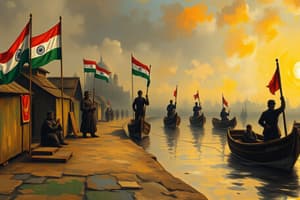Podcast
Questions and Answers
What was one significant impact of nationalism in India during the early 20th century?
What was one significant impact of nationalism in India during the early 20th century?
- Strengthening of regional identities over national unity
- Complete acceptance of British rule by the Indian populace
- Emergence of a unified independence movement against colonial rule (correct)
- Increased cooperation between British officials and Indian leaders
Which leader is most closely associated with the Indian National Congress during the nationalist movement?
Which leader is most closely associated with the Indian National Congress during the nationalist movement?
- Jawaharlal Nehru
- Subhas Chandra Bose
- Sardar Vallabhbhai Patel
- Mahatma Gandhi (correct)
Which of the following was a tactic used by Indian nationalists to oppose British rule?
Which of the following was a tactic used by Indian nationalists to oppose British rule?
- Non-cooperation and boycotting British goods (correct)
- Diplomatic negotiations with foreign governments
- Armed rebellion against the British military
- Forming alliances with local monarchies
What role did the Partition of Bengal in 1905 play in Indian nationalism?
What role did the Partition of Bengal in 1905 play in Indian nationalism?
What was the primary goal of the Salt March led by Gandhi in 1930?
What was the primary goal of the Salt March led by Gandhi in 1930?
Flashcards
Nationalism in India
Nationalism in India
The feeling of unity and pride in one's nation, especially among Indians during a specific historical period
Indian Nationalists
Indian Nationalists
People who actively worked for India's independence and national unity.
Causes of Indian Nationalism
Causes of Indian Nationalism
Multiple factors that fueled the desire for a separate Indian identity.
Role of Leaders
Role of Leaders
Signup and view all the flashcards
Impact of Nationalism
Impact of Nationalism
Signup and view all the flashcards
Study Notes
Rise of Nationalism in India
- The British East India Company's control expanded gradually, leading to economic exploitation and political subjugation.
- Initial resistance was localized and lacked a unified goal.
- Factors like economic hardship, political grievances, and social injustices fueled the growing discontent.
- The introduction of modern education and the rise of the press played a significant role in spreading awareness and nationalist ideas.
- Exposure to Western liberal ideals and nationalist movements in other parts of the world further inspired Indian intellectuals.
Key Figures and Movements
- Early Nationalist Leaders: Raja Ram Mohan Roy, Dayanand Saraswati, and others advocated for social reform and challenged British policies.
- The Indian National Congress (INC): Founded in 1885, the INC initially aimed for greater participation of Indians in the administration.
- Moderate Phase: Leaders like Dadabhai Naoroji and Gopal Krishna Gokhale advocated for gradual reforms and peaceful methods. They focused on issues like legislative reforms and civil services.
- Radical Phase: Leaders like Bal Gangadhar Tilak, Bipin Chandra Pal, and Lala Lajpat Rai emphasized stronger methods of protest, including Swadeshi (boycott). They also championed the idea of self-rule (swaraj).
Factors Contributing to Nationalism
- Economic Exploitation: British policies led to the drain of wealth, exploitation of resources, and economic hardship for Indians. The imposition of tariffs and trade restrictions harmed local industries.
- Political Grievances: Limited opportunities for Indians in the administration and the lack of political power fueled resentment.
- Social Injustices: Caste discrimination, religious intolerance, and the discriminatory practices of the British affected various sections of the population.
- Rise of the Press: Newspapers and journals played a crucial role in spreading nationalist ideas, exposing injustices, and mobilizing public opinion.
- Impact of Western Education: Exposure to Western liberal ideals and concepts of democracy and self-determination inspired the Indian intelligentsia.
- Nationalist Movements Abroad: Inspired by nationalist movements in other parts of the world, Indians recognized the possibility of achieving self-rule.
- Religious Movements: Religious movements also contributed to the rise of nationalism by emphasizing unity and a shared identity.
Different Approaches to Nationalism
- Moderate Nationalists: Advocated for gradual reforms, peaceful methods, and cooperation with the British.
- Radical Nationalists: Emphasized swadeshi, self-reliance, and stronger methods of protest to achieve self-rule.
- Emergence of Militant Nationalism: Inspired by the growing influence of the radical nationalists, some members of Indian society embraced violent methods for the achievement of their goals. However, this was not universally accepted and played a smaller role in the overall process of independence compared to the more established moderate and radical movements.
Impact of Nationalism
- Unity and Solidarity: Nationalism fostered a sense of unity and common purpose among diverse groups of people across India.
- Awareness and Mobilization: Nationalist activities generated awareness about the plight of Indians under British rule and mobilized people to fight for self-rule.
- Demand for Self-Rule: Nationalist movements progressively demanded self-rule (Swaraj) and the right to govern themselves.
- Rise of Nationalist Leaders: The movement gave rise to leaders who became crucial in the struggle for independence, each with their own styles and approaches.
- Wider Social Awareness: Nationalist movements raised awareness about social injustices and inequalities, contributing to broader social movements for reform.
Studying That Suits You
Use AI to generate personalized quizzes and flashcards to suit your learning preferences.



